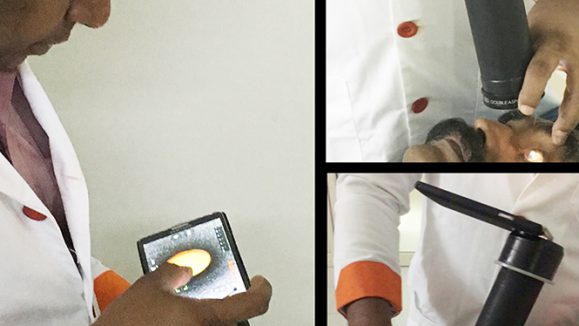Robots may soon take the scalpel away from surgeons and revolutionize surgery – along with other cutting-edge technologies like artificial intelligence (AI) and smart sensors. These are just some of the latest surgical innovations discussed during the PIE Talks series at EURETINA 2018, which took place in Vienna, Austria in September.
“If we look at vitreoretinal surgery, we have reached more or less the limits of what we are able to do with our instruments,” said Dr. Marc D. de Smet, founder and chief medical officer of PRECEYES BV, based in Eindhoven, The Netherlands. His company develops next generation medical robotics and has created the PRECEYES Surgical System to assist eye surgeons and perform tasks, like vitreoretinal surgeries.
With several advantages over humans (including higher cutting accuracy and precision), robotics could take over the operating theatre. “If you operate, you have in your best years about 100 microns worth of tremor. It is 100 times better if you let the robot carry out the surgery,” said Dr. de Smet.
Delicate retinal surgery often requires precise fine motor control to achieve the best results and reduce surgical risks. Any accidental movement could result in ocular injury. The possibility of integrating the system with intelligent sensors would also revolutionize the field. According to Dr. de Smet, sensors would tell surgeons exactly how far they are from the retinal surface: “So, it tells you if you are going to do something that puts you in the danger zone. You would be able to anticipate just like if a pilot is going too fast and too close to the landing strip, there are warning signs and bells that go off in the cockpit . . . we could do the same thing, so it will make the surgery safer,” he said.
Meanwhile, Dr. Rafiq Hasan, vice-president and global head of ophthalmology at Bayer, also believes robotics could be the way forward. “We are hearing about some really great advances there,” he said, adding that a group in Switzerland is developing a robot that could, in the future, carry out injections in the eye.
Patients with age-related macular degeneration need regular injections, and these are currently administered by trained doctors. With robotics, the injection could be much safer and more precise. “‘The heartbeat itself can cause a slight tremor, and when you are dealing with something as delicate as the eye, the ability to remove that tremor using robotics could be significantly advantageous in how a clinician operates on the eye,” said Dr. Hasan.
“You have greater assurance that they are injecting in the right place, and at the same time, injecting the right volume. There are many ways in which I think we can combine that skill of the clinician with technology to improve how we manage patients,” added Dr. Hasan. He also noted that there has been a lot of progress in AI over the last year or two, with a big movement in the United Kingdom in that direction.
Moorfields Eye Hospital (London, United Kingdom) is currently looking at whether AI algorithms could help physicians understand and interpret optical coherence tomography (OCT) images. Patients can be screened remotely using this method and see a physician only if they need to. Dr. Hasan said that Bayer is currently working on a tool to improve patient education and outcomes. “Almost 50 percent of diabetic macular edema patients were discontinuing with treatment even though they are aware that they are at risk of going blind and effective injections are available,” said Dr. Hasan.
“Something that we have been working on is an app that patients can use alongside treatment to better understand how they are progressing, to understand why they have this disease, the underlying mechanism, so we think better patient education, better engagement with their condition and their treatment will lead to better outcomes,” he added.
Mr. Rod Ross, chief executive officer of Med-Logics Inc, Texas, USA, talked about his company’s CataPulse incision device, heralding a new generation of cataract surgery. Designed to do away with ultrasound energy, this phaco-free technology is focused on minimizing the risks of surgery.
Most cataract procedures involve the use of a high-frequency ultrasound device that breaks up the cloudy lens into small pieces, which are then removed. The procedure, called phacoemulsification or “phaco,” can be performed with smaller incisions, promoting faster healing, and reducing the risks of cataract surgery complications, such as retinal detachment. Ultrasound is the cause of many cataract complications, which is what led Mr. Ross to develop the CataPulse, which also makes smaller incisions.
“We have used it in surgery prototypes for seven years with zero complications. That’s where cataract surgery needs to be. We have got to try to eliminate the complications. Patients want rapid visual recovery, and small incisions, they do not want complications,” said Mr. Ross.
On the other hand, Armond Dantino, vice-president of sales at MacuLogix Inc, Florida, USA, said his company has created the only fully automated dark adaptometer commercially available. It can detect age-related macular degeneration (AMD) up to three years earlier, potentially improving patient treatment and providing a better chance at preserving vision. This is crucial, as AMD is a massively growing disease, with 200 million predicted cases by 2020. Early and intermediate stages of AMD often present no symptoms, and it can cause the loss of central vision.
“We want to identify early and hopefully save sight. That’s the whole goal of our company, to provide eye care practitioners with equipment to save sight,” said Mr. Dantino. Early detection is important, as researchers have found links between the disease and lifestyle choices such as smoking.
“If you know you have AMD early, you can change your lifestyle, you can stop smoking, you can exercise, you can eat a good Mediterranean diet with fruit and vegetables. If you believe in nutraceuticals and antioxidants, you can take those as well. If you can maybe push off the progression of the disease as much as you can, it gives you better outcomes later on in life,” added Mr. Dantino.
In addition, James Mazzo, global president of ophthalmology for Carl Zeiss Meditec AG says that the power of AI can be harnessed to assist doctors in diagnosing patients, which would help to overcome the problem where there are more patients and fewer doctors. “Today, doctors don’t have the availability, they don’t have the time to see every one of the patients,” he said.
“If we can use AI to take some of the menial tasks out of our great physicians’ hands and allow them to use more of the capacity of the brain, the patient wins,” he said. This in-depth knowledge can make all the difference to diagnosing a patient.
For Dr. Diva Kant Misra, ophthalmologist from Sri Sankardeva Nethralaya, Guwahati, India, Alcon’s NGENUITY 3D Visualization System which uses a head-up high definition 3D screen for vitreoretinal surgeries is the future, along with AI and robotics.
“I am sure these technologies (robotics and 3D) will integrate at some point in time. Like we have intraoperative OCT, we have 3D visualization, we are doing ILM (internal limiting membrane) peeling with the help of robotics. So, all of these into one, I am sure it will be a great combination. Such technologies would likely have better results for the patient,” said Dr. Misra.
“We would have more predictable results, and it’s better for the patient. That has to be the priority,” he added.
Editor’s Note: This article is an excerpt from PIE Talks 2: Mozart and Ophthalmology, interviews conducted at the EURETINA-ESCRS 2018 joint congress held in Vienna, Austria. Search YouTube for “PIE Talks Episode 02” for the complete videos of the individual interviews.



